Intermittent fasting is an innovative form of fasting which focus mainly on the “timings “ of eating. It is different from other types of diet plans that focus on “what “ to eat. It’s a diet strategy that involves alternating periods of eating and extended fasting (meaning no food at all or very=low-calorie consumption).
With intermittent fasting, you only eat during a specific time and due to this reason fasting for a certain number of hours each day or eating just one meal a couple of days a week, can help your body burn fat. Intermittent fasting works by prolonging the fat-burning period of your body. This fasting method has recently become a health trend. It’s not only claimed to cause weight loss but also improve metabolic health, brain health and perhaps even extend lifespan.
Why do Intermittent Fasting – Benefits Round up
Fasting is a time tested and ancient tradition that has been adopted by our ancestors as well. It has been used not only for weight loss but to improve concentration, extend life, prevent Alzheimer, prevent insulin resistance and even reverse the entire ageng process (to an extent). Numerous celebrities can be found using this exact method to bring their body to perfect shape.
When you fast, insulin levels drop and human growth hormone increases. Your cells also initiate important cellular repair processes and change which genes they express. Intermittent fasting helps you eat fewer calories while boosting metabolism slightly. Studies show that intermittent fasting can reduce oxidative damage and inflammation in the body. Intermittent fasting can also improve numerous risk factors for heart disease such as blood pressure, cholesterol levels, triglycerides and inflammatory markers. This fasting method helps triggers a metabolic pathway called autophagy, which removes waste material from cells. It may also have direct benefits on brain health.
How this Works – Various methods outlook
There are several different ways to do intermittent fasting, but they are all based on choosing regular time periods to eat and fast. For instance, you might try eating only during eight-hour period each day and fast for the remainder. Or you might choose to eat only one meal a day. Here are a few of the most popular methods.

1. OMAD
That stands for One Meal A Day, and it’s an extreme form of intermittent fasting that involves eating only one meal in a whole 24-hour window. It is one of the most popular fasting methods. It allows you to eat whatever you want, including junk food, but when you’re not eating, you’re only allowed to drink calorie-free beverages like black coffee and water. While there are no restrictions on how many calories can be eaten during this window, it’s advised that you sit down for your meal at the same time each day but no harm in enjoying your meal any time of day — morning, noon or night — although it is recommended eating your meal in the evening. This form of fasting is quite an easy and sustainable way to lose weight and enjoy your favourite food. It might be hard at the start, but your body will adapt eventually and there will be no cravings during the day. The objective is that by limiting yourself to just one “feeding” per day, you’re technically reducing your overall caloric intake across 24 hours, thus automatically losing weight without having to cut out certain food groups or tracking macros or calories like many other weight-loss diets.
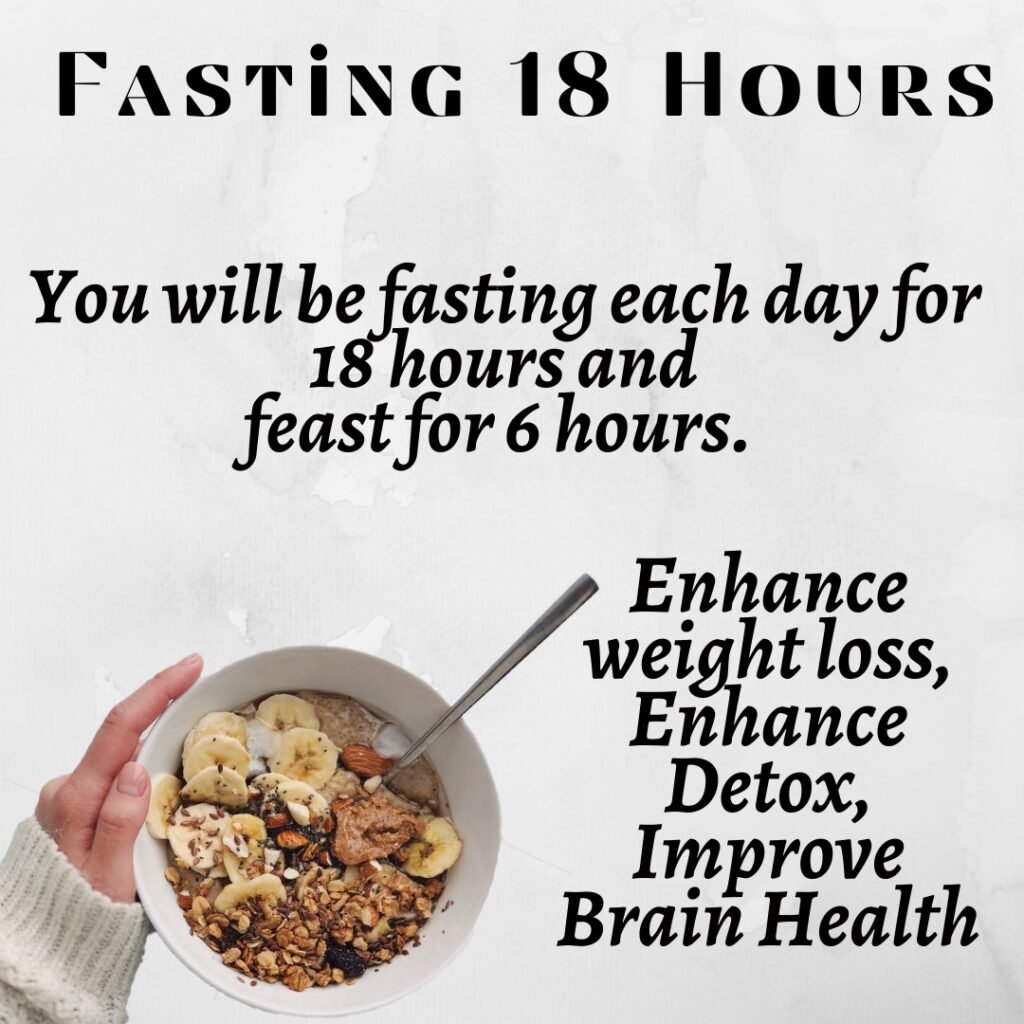
2. 18-hours Fasting
This is an advanced version of the Wolverine diet. You will be fasting each day for 18 hours and have a feast for 6 hours. In the first 12 hours of fasting, your body burns glycogen (a molecule that stores sugar) and in the last 12 hours, it starts to burn fat stores(ketosis). Most people will be able to stay 1 or 2 hours in a state of ketosis. This type of fasting will lead to more weight loss compared to the 16 hours of fasting because of a smaller eating window. You have to manage to consume all your calories within those 6 hours. In that time, you can have 2 full meals and a snack. You can choose either to skip breakfast and have early dinner, or to skip dinner and have a late lunch, or adjust your eating schedule to your personal preference with the condition that your meals should be within the 6-hour window. And for the rest of the day, you need to stick to a healthy well-balanced diet, if you want to improve your wellness and slim down a couple of sizes.
Try to avoid sugary foods and drinks, junk food, and other products filled with unhealthy components such as trans and saturated fats. This is a much more rigid form of intermittent fasting and best saved for experienced fasters who’ve tried other methods.
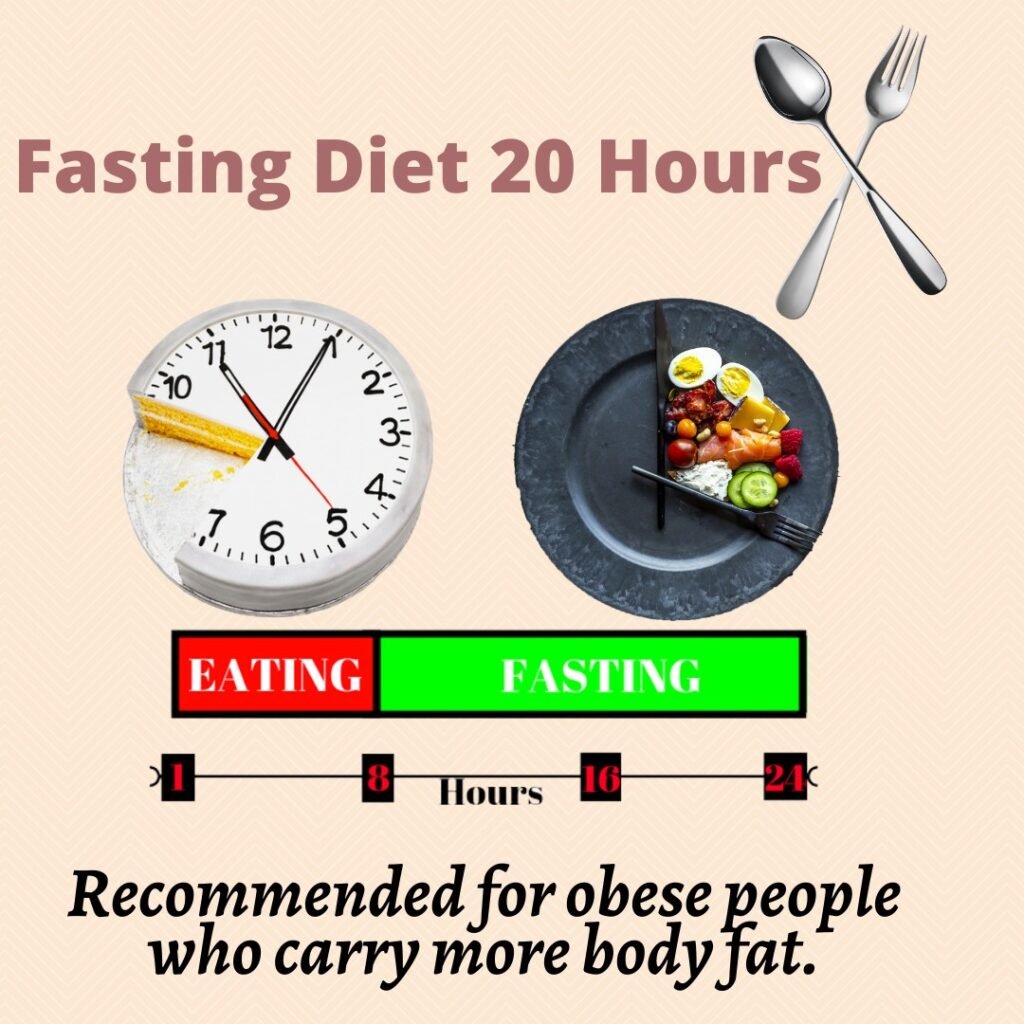
3. 20-hours Fasting
This is an advanced version of the 20 hours fasting regime. You will fast each day for 20 hours and eat inside 4 hours window. This fasting regime is not easy and it is mostly recommended for obese people who carry more body fat. With the 20 hours fasting, you will be able to stay 2 to 4 hours into the state of ketosis (burning fast), improve skin health and digestion. This would involve eating either one large, lengthy meal or two smaller meals within this period. Most people who decide to take this on, usually start on the 16/8 plan, and gradually increase the number of fasting hours The 20/4 method is not one that anyone should jump right into as it can be very difficult to follow and can end up making you feel completely unmotivated and queasy, Because the eating window is so small, you really won’t have enough time to eat more than 1-2 meals per day. Most people will focus on eating a big meal that contains most of the calories they need for the day.

4. Warrior Fasting
The warrior diet is a fasting regime that is based on the eating patterns of ancient warriors, who consumed little during the day and then feasted at night. This type of diet focuses on eating healthy. It allows you to eat during the day while not breaking your fasting, so it makes it easier to sustain. This program includes meal plans and the most efficient home workouts for fat loss. In contrast to other methods, you are allowed to eat some raw fruits and vegetables, and some lean protein during the 20-hour fast period. This fasting schedule is based on the idea that our ancestors spent their days hunting and gathering and would then feast at night. Therefore the 4-hour eating window shall be in the evening and you should follow a special order of eating specific food groups: starting with vegetables, proteins and fat, and eating carbs only if you are still hungry. Another thing about this diet is that it emphasizes food choices that are similar to a paleo diet. Even though this can be a challenge to follow, the big meals at the end of the day will be very rewarding and you will be feeling your best since you will only be consuming unprocessed and whole foods.

5. 36-hours Fasting
This kind of fasting is focused on longevity, body healing, and autophagy. It should be performed only once per week, or a few times a month. Your body will hit autophagy – a process of regeneration where the body cleans damaged cells and creates newer healthier cells. It is also a very quick and aggressive way to lose body fat. By the end, you will burn around 1-2 kg of body fat. During this fasting, it is important to take electrolyte supplements. The best way to do this type of fasting is to eat dinner on day 1, you would fast for all of day 2 and not eat again until breakfast on day 3. This is generally 36 hours of fasting. This might provide a more powerful weight-loss benefit and may help avoid the temptation to overeat dinner on day 2. After a 36-hour fast, when you start eating again you continue to burn fat in excess of glycogen (carbohydrate) for energy.
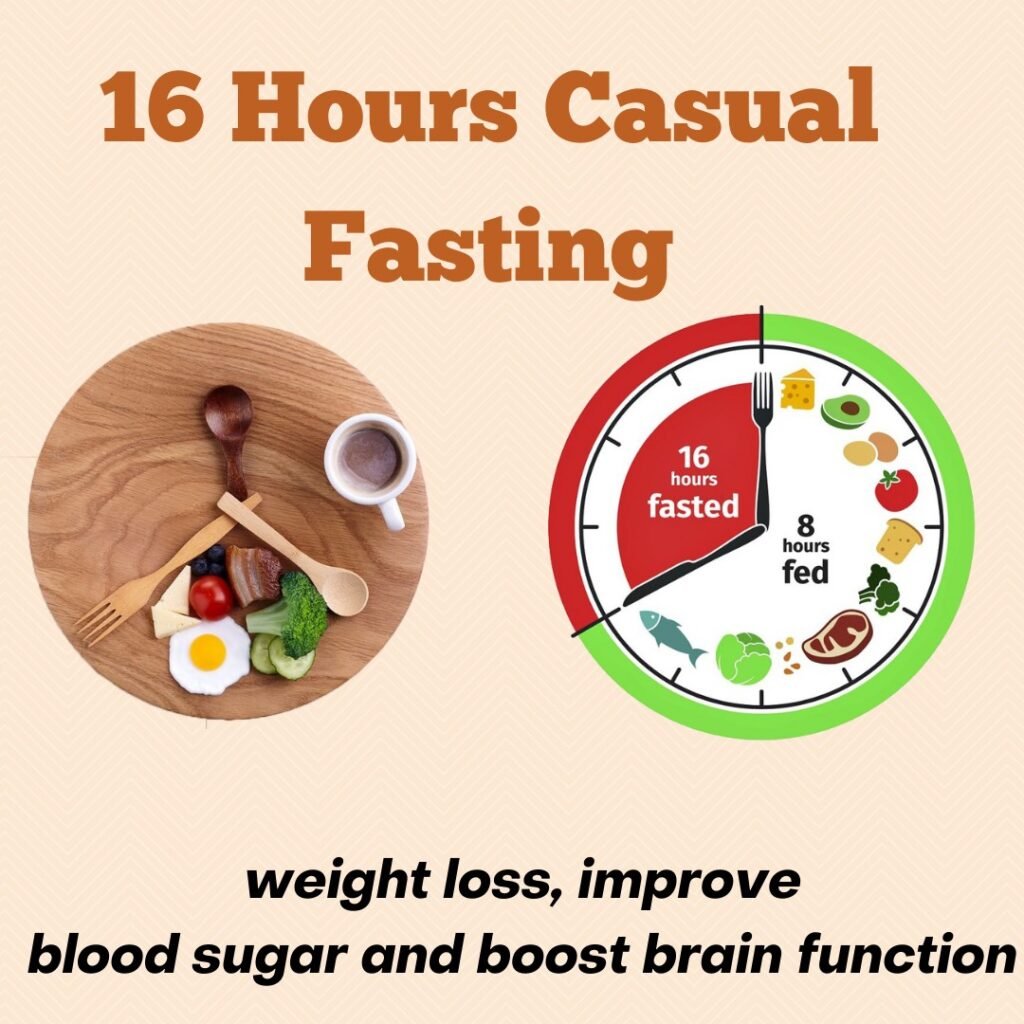
6. 16-hours casual Fasting
This type of fasting involves eating only during an eight-hour window during the day and fasting for the remaining 16 hours. This is one of the easiest and beginner-friendly fasting programs. You can start by fasting for 16 hours and eating for 8 hours. There are no food limits. This kind of regime will promote weight loss, improve energy, and give a rest to your digestive system. It may support weight loss, improve blood sugar, boost brain function and increase longevity. While other diets often set strict rules and regulations, it is relatively easy to follow and can provide real results with minimal effort. The fasting cycle can be repeated as frequently as you like — from just once or twice per week to every day, depending on your personal needs and that is the reason this fasting is popular because it’s easy to follow, flexible and sustainable in the long term. There are no restrictions on the types or amount of food that a person can eat during the 8-hour window. The easiest way to follow this plan is to choose a 16-hour fasting window that includes the time that a person spends sleeping.
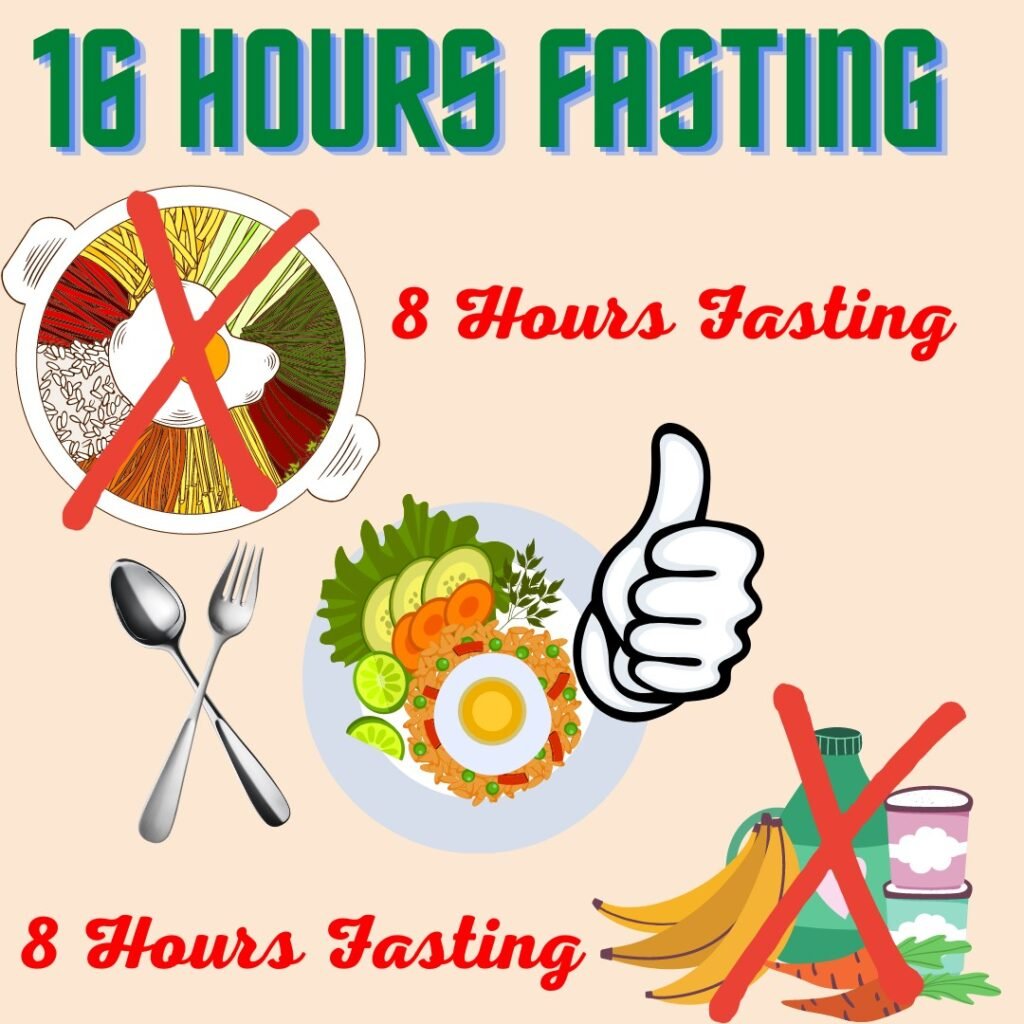
7. 16-hours Fast
This method is also known as Wolverine Diet as it is popularized by Hugh Jackman who used this type of fasting to build his Wolverine body. Eating all of his daily calories in the 8-hour eating period and followed by 16 hours long fast every day. For him, this 8 hours eating window started at 10 am and ended at 6 pm. So, the fasting period for him was mostly spent in the evening and night, resting his body and sleeping. This is a brilliant technique that provides sufficient time for the body to heal after a workout and prevents hunger and unhealthy food cravings. During this 8-hrs window, you must be doing some special workouts along with consuming healthy foods. Workouts always benefit greatly in intermittent fasting protocol. You can carry out gym sessions in the mornings, while the body is still in the fasting state.

8. 24-hours Fasting
Quite simply a twenty-four fast is a day in which no food is consumed. It is advised however that individuals consume water, and in most cases, black coffee and or green tea is also allowed. Additionally, If you have never fasted before, approaching a 24 hour fast might seem like a huge task to take on & it is preferred to start with 16 hours fasting plan and slowly push to 24-hours fasting. The goal of this fasting regime is to reach Autophagy – cell regeneration. While your body is in a fasted state, since no food or ‘fuel’ is coming in, your body must rely solely on what you already have within your body as a fuel source. While your body is focusing on finding a fuel source within, it has the chance to get rid of any ‘junk’ cells, which can include dead, dying or damaged cells. In this 24-hours fasting period, the liver goes through a process known as lipolysis, which is the breaking down or ‘burning’ of fat. Fasting can help improve this function through autophagy, so your body can burn more fat, more efficiently. Also, studies have shown it leads to healthier skin and longevity. As we can still reach this state by consuming tea and black coffee, it is advised to drink only water to achieve complete autophagy.
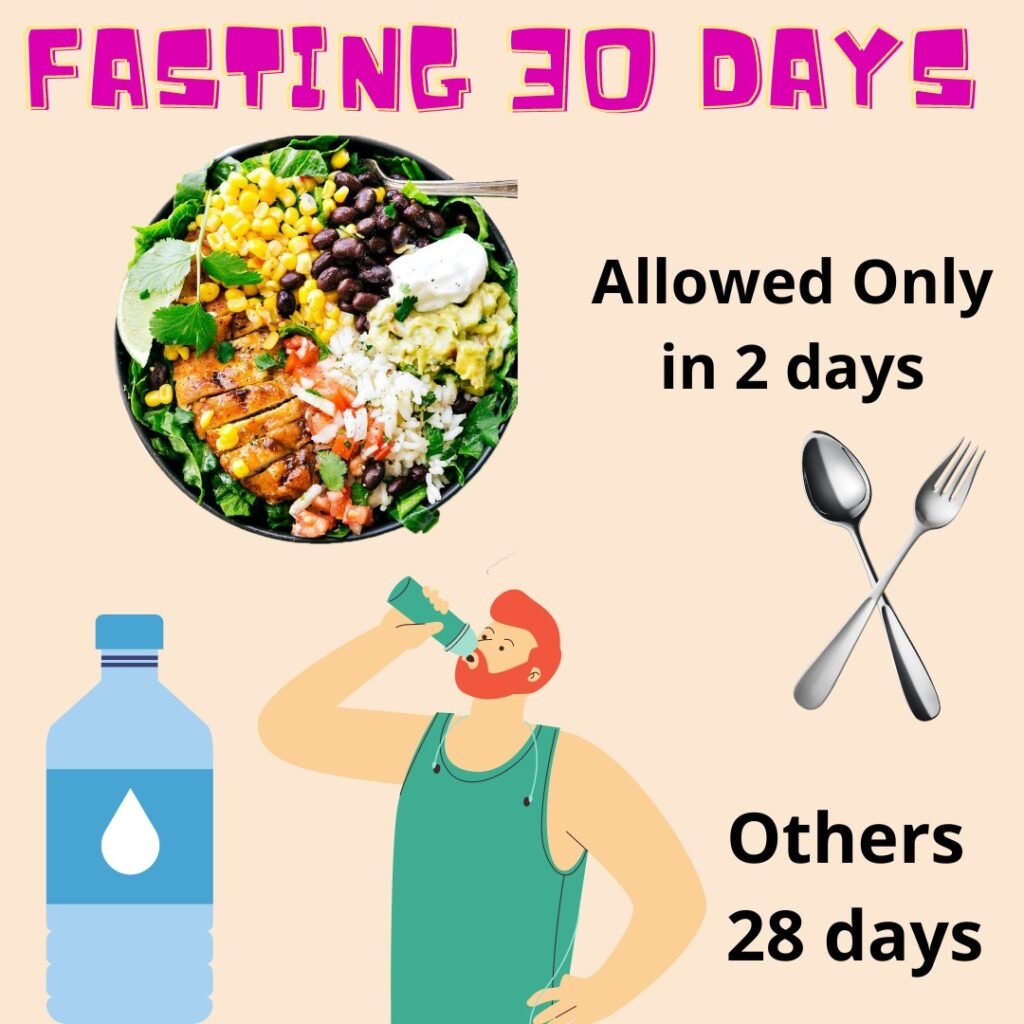
9. 30 days quick Fasting
It is the toughest form of fasting and not recommended to people who have never done any type of fasting in the past. This is a plan that is made to get in shape within 30 days. It consists of 28 days of the regime where you can use only water consumption and 2 days of cheat days where you are allowed to eat whatever you like. It is quite demanding and it includes meal plans and home workouts. If you follow the plan, you can easily drop 10% to 15% of bodyweight because various studies revealed that by adopting this 30 days fasting plan, the human body loses approximately 0.9 kg weight every day which leads up to 25 kg in the whole 30-day period. This method of fasting can especially help bulky bodies, stubborn belly fat and people who are averaging 100+ kg to reduce max weight and made their bodies under satisfactory weight bracket.

10. Blitz Fasting
A quick way to lose 15% of body weight in just 10 days. It is extremely demanding and it includes a meal plan and home workout routine. This plan is widely adopted by teenagers and young adults. First few days can be more challenging and full of cravings but as days pass, this becomes easy to adopt. Creamy Coffee in the breakfast help pass the whole day effectively and cleanses junk cells from the body. The plan is created to force your body to use stored body fat as energy and preserve muscle mass. It is recommended to eat enough protein while in a caloric deficit and do strength training this prevents major muscle loss.
Zero Calories Fasting Tracker App – Features
First things first – It is a digital diary in your pocket to track your fasting plan. It allows users to modify fasting time and length of the fast, track body weight, body measures, ketones, glucose and body fat. This app is best of its kind so far and consists of all features that can be easily converted into home screen widget. In this way, user can use all the features without actually opening the app and can just tap to start or end a fast. It tracks your IF time and sends a push notification when you have completed your fasting goal
In addition to that, this app offers collaborative diet by enabling the use of group fasting for fast with your friends and family. You can measure Body Mass Index – BMI to get an insight of your health score and compare the figures and Index with your group.
This app tracks numbers based on highly advanced science-based statistical data and that data can be exported as .csv file to your desktop or mobile devices. Apart from this, the GUI of the app is fully customizable in respects of colours and positioning. All health characteristics like Body fat, Glucose Levels, Ketone Levels, weight & water intake are exhibited and plotted on Graph levels for easy analyzing and understanding. It’s available to download on both Android & Apple Store.

